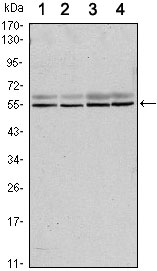SMAD6 Antibody
Purified Mouse Monoclonal Antibody
- 产品详情
- 实验流程
Application
| WB, E |
|---|---|
| Primary Accession | O43541 |
| Reactivity | Human |
| Host | Mouse |
| Clonality | Monoclonal |
| Clone Names | 5H3 |
| Isotype | IgG1 |
| Calculated MW | 53497 Da |
| Description | Antagonist of signaling by TGF-beta (transforming growth factor) type 1 receptor superfamily members; has been shown to inhibit selectively BMP (bone morphogenetic proteins) signaling by competing with the co-SMAD SMAD4 for receptor-activated SMAD1. SMAD6 is an inhibitory SMAD (I-SMAD) or antagonistic SMAD. Binds to regulatory elements in target promoter regions.Tissue specificity: Ubiquitous in various organs, with higher levels in lung. Isoform B is up-regulated in diseased heart tissue. |
| Immunogen | Purified recombinant fragment of human SMAD6 expressed in E. Coli. |
| Formulation | Ascitic fluid containing 0.03% sodium azide. |
| Gene ID | 4091 |
|---|---|
| Other Names | Mothers against decapentaplegic homolog 6, MAD homolog 6, Mothers against DPP homolog 6, SMAD family member 6, SMAD 6, Smad6, hSMAD6, SMAD6, MADH6 |
| Dilution | WB~~1/500 - 1/2000 E~~N/A |
| Storage | Maintain refrigerated at 2-8°C for up to 6 months. For long term storage store at -20°C in small aliquots to prevent freeze-thaw cycles. |
| Precautions | SMAD6 Antibody is for research use only and not for use in diagnostic or therapeutic procedures. |
| Name | SMAD6 |
|---|---|
| Synonyms | MADH6 |
| Function | Transforming growth factor-beta superfamily receptors signaling occurs through the Smad family of intracellular mediators. SMAD6 is an inhibitory Smad (i-Smad) that negatively regulates signaling downstream of type I transforming growth factor-beta (PubMed:10647776, PubMed:10708948, PubMed:10708949, PubMed:16951688, PubMed:22275001, PubMed:30848080, PubMed:9436979, PubMed:9759503). Acts as a mediator of TGF-beta and BMP anti-inflammatory activities. Suppresses IL1R-TLR signaling through its direct interaction with PEL1, preventing NF-kappa-B activation, nuclear transport and NF-kappa-B- mediated expression of pro-inflammatory genes (PubMed:16951688). Blocks the BMP-SMAD1 signaling pathway by competing with SMAD4 for receptor- activated SMAD1-binding (PubMed:30848080, PubMed:9436979). Binds to regulatory elements in target promoter regions (PubMed:16491121). |
| Cellular Location | Nucleus. |
| Tissue Location | [Isoform B]: Expressed in the brain, heart, ovary, peripheral blood leukocytes, small intestine, spleen, thymus, bone marrow, fetal liver and lymph nodes. |
Research Areas
For Research Use Only. Not For Use In Diagnostic Procedures.
Application Protocols
Provided below are standard protocols that you may find useful for product applications.
REFERENCES
1. J Biol Chem. 2006 Feb 10;281(6):3569-76. 2. Nat Immunol. 2006 Oct;7(10):1057-65. 3. J Med Genet. 2009 May;46(5):331-7.
终于等到您。ABCEPTA(百远生物)抗体产品。
点击下方“我要评价 ”按钮提交您的反馈信息,您的反馈和评价是我们最宝贵的财富之一,
我们将在1-3个工作日内处理您的反馈信息。
如有疑问,联系:0512-88856768 tech-china@abcepta.com.























 癌症的基本特征包括细胞增殖、血管生成、迁移、凋亡逃避机制和细胞永生等。找到癌症发生过程中这些通路的关键标记物和对应的抗体用于检测至关重要。
癌症的基本特征包括细胞增殖、血管生成、迁移、凋亡逃避机制和细胞永生等。找到癌症发生过程中这些通路的关键标记物和对应的抗体用于检测至关重要。 为您推荐一个泛素化位点预测神器——泛素化分析工具,可以为您的蛋白的泛素化位点作出预测和评分。
为您推荐一个泛素化位点预测神器——泛素化分析工具,可以为您的蛋白的泛素化位点作出预测和评分。 细胞自噬受体图形绘图工具为你的蛋白的细胞受体结合位点作出预测和评分,识别结合到自噬通路中的蛋白是非常重要的,便于让我们理解自噬在正常生理、病理过程中的作用,如发育、细胞分化、神经退化性疾病、压力条件下、感染和癌症。
细胞自噬受体图形绘图工具为你的蛋白的细胞受体结合位点作出预测和评分,识别结合到自噬通路中的蛋白是非常重要的,便于让我们理解自噬在正常生理、病理过程中的作用,如发育、细胞分化、神经退化性疾病、压力条件下、感染和癌症。






